Architectural Marvels in Malaysia: Lasting Traditions, Modern Spaces and Immaculate Views
- Lim Jia Chin
- May 21
- 14 min read

(Source: Google Map)
If there’s one thing Malaysia is famous for, it’s our super diverse architecture. You see it everywhere from colonial shophouses and grand mosques to futuristic skyscrapers all mixed together. Every building has a story, some going way back while others are shaping the skyline right now. Whether you're into history or just looking for cool photo spots, here are some of Malaysia’s most stunning architectural gems that blend old and new perfectly!
1. Petronas Twin Towers, Kuala Lumpur
If you're in KL, you can't miss the iconic Petronas Twin Towers. Soaring 451.9 meters high, they are among the tallest buildings in the world and a proud symbol of Malaysia. Their design, inspired by Islamic geometric patterns, showcases a stunning blend of engineering brilliance and cultural heritage.

(Source: Petronas Twin Tower google map)
From the outside, the towers already look super impressive, but trust me, it's even better inside. Grab a ticket and take the futuristic high-speed elevator up to the 86th-floor observation deck. At 370 meters up, you'll get a mind-blowing, Insta-worthy view of KL's skyline, one you won't find anywhere else.

(Source: Petronas Twin Tower google map)

(Source: Petronas Twin Tower google map)
And of course, you must check out the Skybridge. This is the world’s highest double-deck bridge, linking the towers at the 41st and 42nd floors, 170 meters above the ground. Walking across it is definitely an experience.
Before you leave, swing by the gift shop for some cool souvenirs. Whether you're here for the views, the history, or just to say you've been, the Twin Towers are a must-visit in KL.
Address:
201A-C, Jln Ampang, Kuala Lumpur City Centre, 50088 Kuala Lumpur, Wilayah Persekutuan Kuala Lumpur
Opening Hours:
Tuesday – Sunday and Public Holidays: 9:00 AM to 9:00 PM
(Last admission at 8:30 PM; open throughout Friday prayers)
Closed on Mondays except for the 2nd and 4th Monday of the month, or if a public holiday falls on a Monday.
Official Website:
Instagram:
Facebook:
Admission Fee:
Malaysian Citizens (MyKad holders):
Adults (13 – 60 years old): RM35 (~SGD 9.80)
Children (2 – 12 years old): RM17 (~SGD 4.75)
Senior Citizens (61 years and above): RM17 (~SGD 4.75)
Non-Malaysian Citizens:
Adults (13 – 60 years old): RM98 (~SGD 27.50)
Children (2 – 12 years old): RM50 (~SGD 14)
Senior Citizens (61 years and above): RM50 (~SGD 14)
Google Map:
2. Sultan Abdul Samad Building, Kuala Lumpur
Next up, we have the iconic Sultan Abdul Samad Building, one of KL’s most stunning colonial-era landmarks. Built in 1897, this historical gem stands out with its Moorish-inspired architecture, featuring grand arches, two towering minarets, and a gleaming copper dome.

(Google Map: Sultan Abdul Samad Building Google Map)
The clock tower is the star of the show, standing tall with its 1-ton bell that chimes every 30 minutes. This place has seen it all, from its early days as the British administration office to later housing Malaysia’s Federal Court. However, what makes it even more special is its location. It sits right on Merdeka Square, the very spot where Malaysia’s first Prime Minister, Tunku Abdul Rahman, declared independence in 1957 with the iconic shout of "Merdeka!"

(Google Map: Sultan Abdul Samad Building Google Map)
Today, it remains a symbol of Malaysia’s journey from colonial rule to independence. Whether you're into history, architecture, or just looking for a cool backdrop for your photos, this is one spot in KL you shouldn’t miss!
Address:
Jalan Raja, Kuala Lumpur City Centre, 50050 Kuala Lumpur, Malaysia
Opening Hours:
The building’s exterior is accessible to the public 24 hours daily. However, interior access is restricted as it houses government offices.
Admission Fee:
There is no charge to view the building’s exterior.
Google Map:
3. Istana Negara (National Palace), Kuala Lumpur
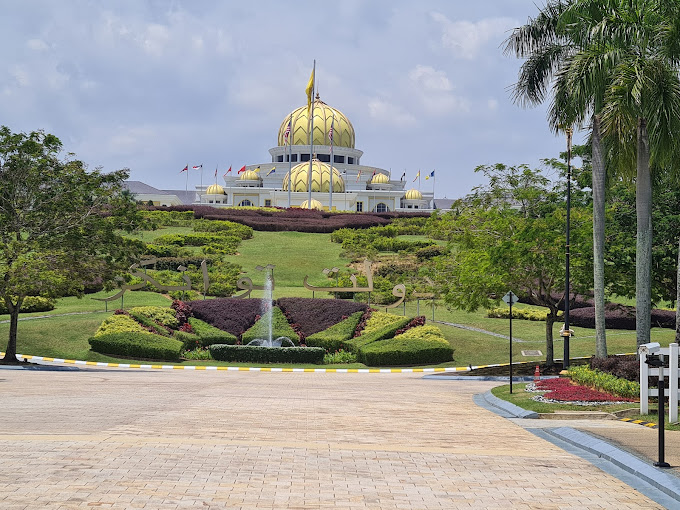
(Source: Istana Negara Google Map)
The Istana Negara, home to the King of Malaysia, is one of the most impressive landmarks in Kuala Lumpur. Sitting on a small hill, the palace looks straight out of a royal fairytale, with its golden domes and beautifully landscaped gardens filled with flower beds, manicured lawns, ponds, and fountains. Unfortunately, you can’t go inside. Tourists and locals can only admire it from behind an elaborate fence, which is a masterpiece on its own.

(Source: Istana Negara Google Map)
But here’s something cool. Once a year, the palace gates actually open to the public! If you’re lucky enough to visit during that time, you’ll get to step inside and even enjoy some special treats. The entrance is guarded by both horse-mounted and foot soldiers, dressed in striking uniforms inspired by the British colonial era. If you have time, don’t miss the Changing of the Guard ceremony. It’s quite a sight!

(Source: Istana Negara Google Map)

(Source: Istana Negara Google Map)
Oh, and here’s a fun fact. You can tell if the King is home just by looking at the yellow flag on the tallest flagpole. If it’s raised, he’s in. If it’s down, he’s away. If you visit and see the flag up, that means the King is home!
Address:Jalan Tuanku Abdul Halim, 50480 Kuala Lumpur, Malaysia
Opening Hours:
The palace itself is not open to the public for regular visits.
However, visitors can view the main gate and exterior at any time.
The Changing of the Guard ceremony takes place daily at the entrance.
When is the palace open to the public?
The palace gates are occasionally opened to the public on special occasions, such as the King's official birthday and other royal events. Specific dates for 2025 have not been announced yet. For the most accurate and up-to-date information, please refer to the official announcements on the Istana Negara website.
Admission Fee:
Free (Viewing from the outside)
Google Map:View on Google Maps
4. Masjid Putra (Putra Mosque), Putrajaya
If there’s one mosque in Malaysia that will make you stop and admire its beauty, it’s the Putra Mosque. With its soft pink dome and stunning lakeside location, it looks like something straight out of a postcard.

(Source: Masjid Putra Google Map)
That pink color? It comes from rose-tinted granite, giving the whole place a dreamy and elegant vibe. Inside, the massive prayer hall can fit up to fifteen thousand people. The design is inspired by Morocco’s King Hassan Mosque, blending Middle Eastern and Malay styles in a way that feels both grand and welcoming.
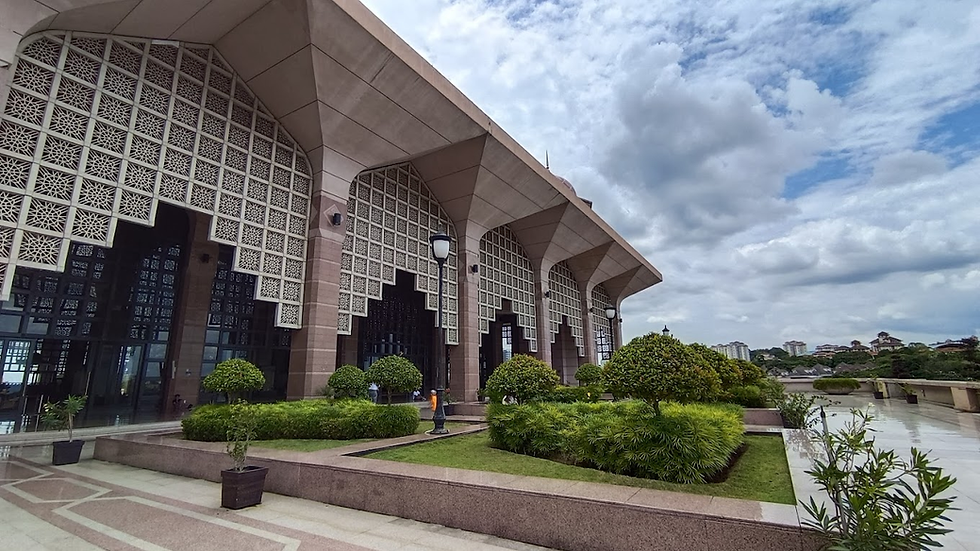
(Source: Masjid Putra Google Map)
The mosque has three main sections: the prayer hall, the courtyard, and a few study rooms and event spaces. The prayer hall, held up by twelve towering pillars, is peaceful yet majestic, with a dome that reaches two hundred and fifty feet high. But my favorite part? The courtyard. With its flowing fountains, long archways, and open space, it has this calm and soothing atmosphere that makes you want to just sit and take it all in.

(Source: Masjid Putra Google Map)
And then there’s the minaret. At one hundred and sixteen meters tall, it’s one of the highest in the region, inspired by the Sheikh Omar Mosque. It has five levels, each symbolizing one of the five pillars of Islam: faith, prayer, fasting, charity, and pilgrimage. Even if you’re not familiar with these, you can’t help but appreciate the thought and meaning behind the design.

(Source: Masjid Putra Google Map)
What makes this mosque even more special is its location. Sitting right by Putrajaya Lake, the views are breathtaking, especially at sunset when the sky turns golden and reflects off the water. Whether you’re here to admire the architecture, take some photos, or just soak in the peaceful vibes, it’s definitely a place worth visiting. If you ever get the chance, don’t just pass by, take a moment to really appreciate it!
Address:
Persiaran Persekutuan, Presint 1, 62000 Putrajaya, Wilayah Persekutuan Putrajaya, Malaysia.
Opening : Sun–Thu, Sat: 9:00 – 16:00
Fri: 9:00 – 11:00 , 15:00 – 16:00
Official Website: Masjid Putra official website
Facebook: Masjid Putra Facebook
Instagram: Masjid Putra Instagram
Admission Fee:
Entry is free for all visitors.
Google Map: View on Google Map
5. Malacca’s A Famosa & St. Paul’s Church
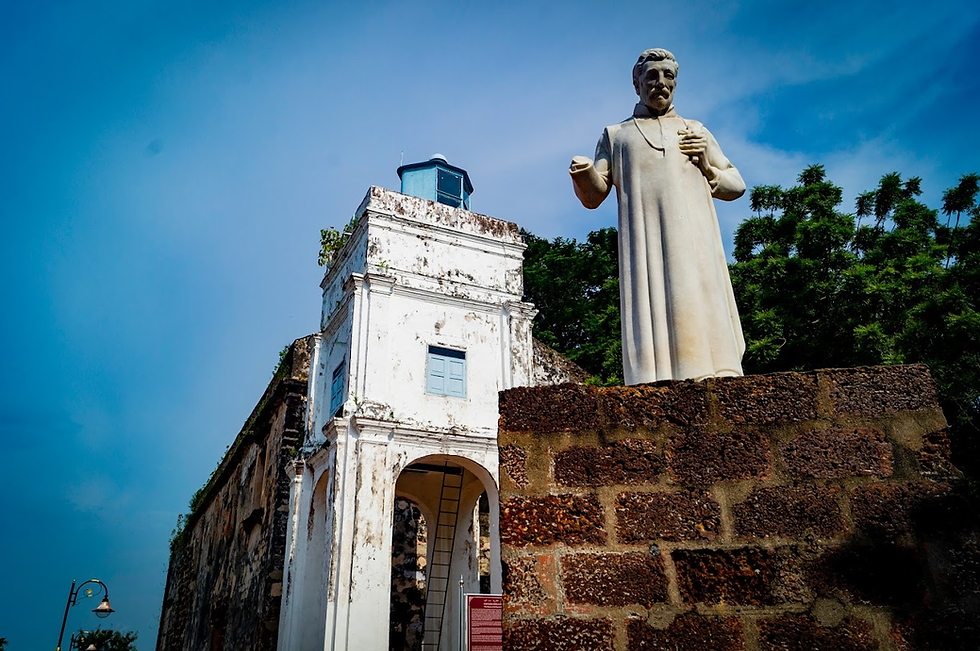
(Source: A Famosa Google Map)
A Famosa is one of the oldest European architectural sites in Southeast Asia and a striking reminder of Malacca’s Portuguese colonial past. Built by the Portuguese in 1511, this fortress has stood for centuries, though today, only the Porta de Santiago gate remains. The name “A Famosa” means “The Famous” in Portuguese, and back in the day, it was meant to be a refuge. But over time, it expanded into a full-fledged Portuguese settlement.

(Source: A Famosa Google Map)
Right next to it, on a hilltop, you’ll find the ruins of St. Paul’s Church, a 16th-century church that adds to the area’s rich historical charm. Walking around, you can almost imagine what life was like during the height of the colonial era. A Famosa was once a powerful military outpost, guarding the city from attacks, and though most of it is gone, the remaining gate still holds so much history.
Address: Jalan Parameswara, Bandar Hilir, 78000 Alor Gajah, Malacca, Malaysia.
Opening Hours: Open daily from 9:00 AM to 6:00 PM.
Official Website: A’Famosa Resort
Instagram: @afamosa_resort
Facebook: A’Famosa Resort
Admission Fee: Entry to the historical site is free; however, nearby attractions like the A’Famosa Resort have separate charges.
Google Map: A Famosa Location
6. Sarawak State Legislative Assembly Building, Kuching

If you’re visiting Kuching, you can’t miss the stunning Sarawak State Legislative Assembly Building. With its golden umbrella-like roof, this nine-story landmark adds a majestic touch to the city’s skyline. When the sun hits just right, the gold shimmers beautifully, making it one of the most eye-catching buildings along the Sarawak River. Seeing it from a distance is already impressive, but it’s even more breathtaking up close.
This building isn’t just about looks. It serves an important role in Sarawak’s government, hosting meetings, ceremonies, and official events. But beyond its function, its design is what really makes it stand out. The nine-pointed roof is inspired by Sarawak’s indigenous culture, blending modern architecture with local traditions in the most elegant way.


The Astana(Source:DBKU)
And while you’re here, you should definitely check out The Astana, the historic governor’s residence built in 1870. Originally a wedding gift from the second White Rajah of Sarawak to his wife, it’s also known as Fort Margherita. Now open to visitors, it offers a glimpse into Sarawak’s past with its romantic and colonial-era charm.

One of the best things about this area is its riverside location. Come in the late afternoon to catch the sunset reflecting off the water, and if you stay after dark, you’ll see the building light up, making the whole place look even more magical.
Address: Pejabat Setiausaha, New Sarawak State Legislative Assembly Building, Petra Jaya, 93502 Kuching, Sarawak
Opening Hours: As this is a government building, it’s not typically open to the public for tours. However, visitors can admire its architecture from the outside and enjoy the surrounding areas.
Official Website: Sarawak State Legislative Assembly Building
Google Map: View on Google Map
7. Batu Caves, Kuala Lumpur

(Source: Batu Caves Google Map)
Another must-visit landmark in Kuala Lumpur is the famous Batu Caves. It’s not just a popular tourist spot but also the heart of the annual Thaipusam festival, drawing thousands of devotees and visitors every year.

(Source: Batu Caves Google Map)
What’s really fascinating is that the limestone forming these caves is around 400 million years old. Back in the day, some of the caves were even used as shelter by Malaysia’s indigenous people. In the 1860s, Chinese settlers started mining bird droppings here to use as fertilizer. However, Batu Caves didn’t really gain global attention until 1878 when it was documented by a colonial explorer and American naturalist, William Hornaday.

(Source: Batu Caves Google Map)
It wasn’t until 1890 that the caves became a major Hindu pilgrimage site. That’s when a temple dedicated to Lord Murugan was built inside, and today, the site is famous for the massive golden statue of him standing at the entrance. No matter if you're drawn to the stunning limestone formations, the vibrant staircase, or the spiritual atmosphere, Batu Caves definitely lives up to the hype.
Address:
Batu Caves, Gombak, 68100 Batu Caves, Selangor, Malaysia
Opening Hours:
6:00 AM to 9:00 PM (Daily)
Official Website:
Instagram:
Facebook:
Admission Fee:
Entrance to the main Temple Cave is free. However, some attractions within the complex, such as the Dark Cave tours, may have separate charges.
Google Map:
Visitor Tips:
Dress Code: As a religious site, visitors are advised to dress modestly. Sarongs are available for rent at the entrance if needed.
Wildlife: The area is inhabited by macaque monkeys known for their mischievous behavior. It’s advisable to secure personal belongings and avoid feeding them.
Best Time to Visit: Early mornings are recommended to avoid large crowds and the midday heat.
designed for defense, it was never actually used in battle. Instead, it ended up serving more as an administrative base than a military stronghold.
8. Kek Lok Si Temple & Penang’s Heritage Shophouses

(Source: The Kek Lok Si Temple Google Map)
Kek Lok Si Temple is the largest Chinese Buddhist temple in Malaysia and an amazing place to visit. Built in 1891 by a monk from Fuzhou, it’s filled with beautiful architecture and rich history. One of the main highlights is the seven-story Pagoda of Ten Thousand Buddhas, which mixes Chinese, Thai, and Burmese designs. There’s also a huge Guan Yin statue standing in an octagonal pavilion supported by 16 towering pillars, making it a truly breathtaking sight.

(Source: The Kek Lok Si Temple Google Map)
The temple isn’t just about grand buildings. It has peaceful gardens, prayer halls with intricate Buddhist statues, and stunning views of George Town. You can even join in traditional blessings or simply soak in the serene atmosphere.

(Source: Kek Lok Si Temple Facebook)
For locals, this temple is more than just a place of worship. Every year before Chinese New Year, it lights up for the Festival of Lights, with thousands of glowing lanterns creating a magical scene. It’s a spot where people come to pray, make wishes, or just enjoy the beautiful surroundings.

(Souce: Pexel)
Beyond its majestic temples, Penang is also famed for its well-preserved heritage shophouses. Strolling through George Town, you'll find rows of these colorful, intricately designed buildings, each telling a story of the island’s multicultural past. A blend of Chinese, Malay, European, and Peranakan influences, these shophouses often feature ornate facades, wooden shutters, and airy inner courtyards. Today, many have been transformed into boutique cafés, charming guesthouses, and art spaces, seamlessly blending old-world charm with modern creativity.
Address: Kek Lok Si Temple, 11500 Ayer Itam, Penang, Malaysia
Opening Hours: 7:00 to 17:30 (Daily)
Official Website: Kek Lok Si Temple
Instagram: Kek Lok Si Temple Instagram
Facebook: Kek Lok Si Temple Facebook
Google Map: https://g.co/kgs/iHq85nk
9. Cheng Hoon Teng Temple, Melacca

(Source: Cheng Hoon Teng Temple Google Map)
Cheng Hoon Teng Temple in Malacca is the oldest Buddhist temple in Malaysia, dating back to 1646. Despite its age, it remains a popular place of worship and a fascinating cultural site. The temple is beautifully decorated with intricate carvings and sculptures, all built according to the highest feng shui principles. It has stood the test of time and is even recognized as a UNESCO World Heritage Site.
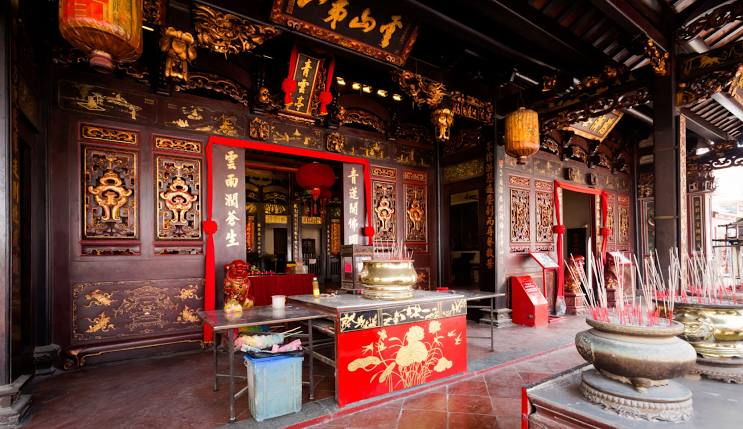
(Source: Cheng Hoon Teng Temple Google Map)
One interesting detail is the faded seven-meter-long red flagpole, which holds the remains of two local chieftains who played a role in the temple’s construction.
Address: 25, Jalan Tokong, 75200 Malacca, Malaysia.
Opening Hours
Mon–Thu, Sat: 07:00–18:00
Fri & Sun: 07:00–20:30
Operating hours may vary.
Official Website: https://www.chenghoonteng.org.my/
Admission Fee: Entrance to the temple is free; however, donations are appreciated to assist with maintenance and activities.
Google Map: View Location
10. Kellie's Castle in Ipoh

(Source; Kellie’s Castle Google Map)
Kellie’s Castle in Ipoh is Malaysia’s own little slice of mystery and romance. Built by a Scottish planter, William Kellie Smith, it was meant to be a grand symbol of love for his wife, just like the Taj Mahal. Unfortunately, the castle was never completed. Many of his workers fell victim to the Spanish flu, and he himself passed away from pneumonia in Portugal before he could see his dream come to life.

(Source; Kellie’s Castle Google Map)
Even so, the story of his love and ambition lives on. With its mix of European and Hindu-inspired architecture, the castle has an almost otherworldly charm. If no one told you, you might just think you had stumbled upon a forgotten European mansion.
Address:
Lot 48436, Kompleks Pelancongan Kellie's Castle, KM 5.5, Jalan Gopeng, 31000 Batu Gajah, Perak
Opening Hours:
Monday to Sunday: 9:30 – 18:00
(Last entry at 5:30 PM)
Official Website:Kellie’s Castle Official Website
Instagram:Kellie’s Castle Official Instagram
Facebook:Kellie’s Castle Official Facebook
Admission Fee:
For Foreign Tourists:
Adults: RM10 (~SGD 2.85)
Children: RM8 (~SGD 2.30)
For Malaysians:
Adults: RM5 (~SGD 1.40)
Children: RM3 (~SGD 0.85)
Google Map:
11. Sultan Ibrahim Building in Johor Bahru
Right in the heart of Johor Bahru, the Sultan Ibrahim Building stands tall as one of the city’s most iconic landmarks. With its mix of Malay and colonial architecture, it definitely has that grand old-school vibe. Fun fact, it was actually the tallest building in JB when it was completed back in 1940.

(Source: Wikipedia)
During World War II, the Japanese took over and used it as a fortress to spy on the British. Later, it became the state government’s headquarters for years. Now it is more of a historical site, but if you are curious to see it up close, just check with security before heading in.
Address: Jalan Bukit Timbalan, 80000 Johor Bahru, Johor, Malaysia
Opening Hours: Monday to Friday, 8:00 – 17:00 ; closed on weekends and public holidays.
Admission Fee: Free of charge.
Google Map: Sultan Ibrahim Building Location
12. The Stadthuys in Melaka

(Source: The Stadthuy Google Map)
Melaka is one of Malaysia’s oldest cities, and if you’re exploring the area, you can’t miss the Dutch Red Square, also known as Stadthuys. Built in the 1650s during the Dutch colonial era, this bright red building is actually the oldest Dutch administrative building in Southeast Asia.

(Source: The Stadthuy Google Map)
It used to be the official residence of Dutch governors, but now it’s a museum packed with fascinating exhibits about Melaka’s colonial history, local culture, and traditional artifacts.
Address:The Stadthuys, Jalan Gereja, 75200 Melaka, Malaysia
Opening Hours (24-hour format):Daily: 09:00 – 17:30
Admission Fee:
Adults: RM5 (~SGD 1.40)
Children: RM2 (~SGD 0.55)
Prices are subject to change.
Google Map:View on Google Maps
13. Crystal Mosque, Terengganu

(Source: Crystal Mosque, Terengganu Google Map)
If you are visiting Terengganu, the Crystal Mosque Masjid Kristal is a must-see. Sitting on Wan Man Island, this stunning mosque is not just a place of worship but a masterpiece of modern Islamic architecture. Built with steel, glass, and crystal, it sparkles in the sunlight during the day and glows beautifully at night. Since its grand opening in 2008, it has become one of Malaysia’s most iconic landmarks, drawing visitors with its unique design and breathtaking reflections on the water.

(Source: Crystal Mosque, Terengganu Google Map)
Step inside to discover a serene prayer hall decorated with intricate Islamic calligraphy and a stunning chandelier that enhances its charm. The mosque is also part of the Islamic Heritage Park, where you can explore replicas of famous Islamic landmarks from around the world. It’s especially breathtaking at sunrise or sunset when it glows with a magical beauty.
Address:
Pulau Wan Man, 21000 Kuala Terengganu, Terengganu, Malaysia
Opening Hours:
6:00 to 23:00 (Daily)
Official Website:
Admission Fee:
No admission fee is required to visit the mosque.
Google Map:
14. Leaning Tower of Teluk Intan
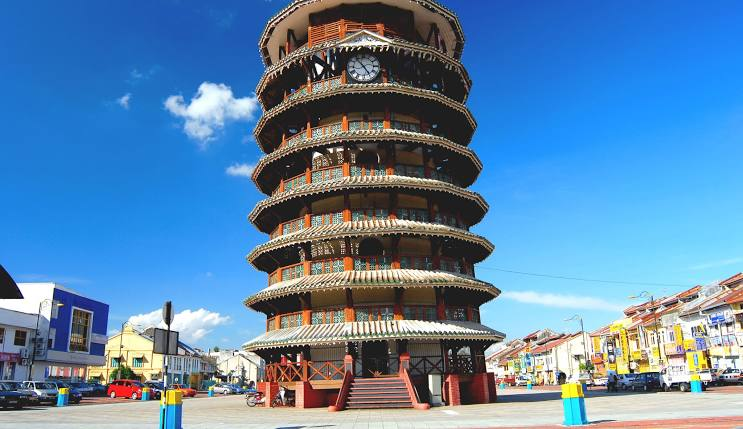
(Source: Leaning Tower of Teluk Intan)
If you’re ever in Perak, the Leaning Tower of Teluk Intan is a must-see. It’s the only leaning tower in Malaysia, built back in 1885 as a water storage tower. But thanks to the soft ground and a shifting foundation, it started tilting over time, giving it its signature look. Today, it’s a proud symbol of Teluk Intan, blending Malay and Chinese architectural influences. You can even climb to the top for a great view of the town and surrounding countryside.
Address:Leaning Tower of Teluk Intan, Jalan Pasar, 36000 Teluk Intan, Perak, Malaysia
Opening Hours :08:00 – 17:00 (Daily)
Admission Fee:
Adults: RM2 (~SGD 0.55)
Children: RM1 (~SGD 0.30)
Prices may change, so check before visiting.
Google Map:View on Google Maps
Your next adventure awaits! Which one will you visit first?

(Source: Freepik)
How many of these places have you been to? If you haven’t checked some of them out yet, why not plan a little trip over the weekend or during the holidays? Every spot has its own story, and seeing it in person just feels different. Malaysia is full of amazing architecture, from historic gems to modern icons, all blending culture, heritage, and innovation. Whether you’re into old-school landmarks or sleek new designs, there’s always something cool to explore. So, which one’s on your must-visit list? Let us know in the comments!







Comments